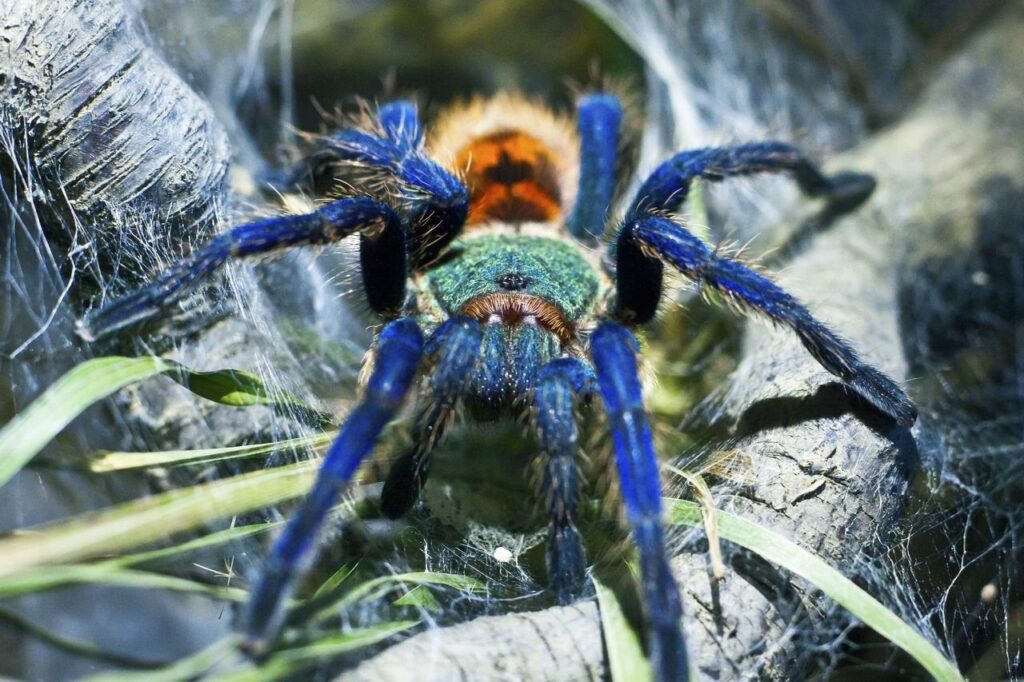Looking for a striking tarantula that’s both beautiful and creates stunning silk web designs? Meet the Greenbottle Blue Tarantula (Chromatopelma cyaneopubescens), an iconic favorite among tarantula keepers. Known for their incredible coloration and spunky personalities, these terrestrial arachnids are a perfect showstopper to add to your collection. Whether you’re here to learn about their care or just admire their beauty, this guide has everything you need to get started!
Species Overview
Scientific Name: Chromatopelma cyaneopubescens
Common Name: Green Bottle Blue Tarantula
Adult Size: 6+ inches
Life Span: Males +/- 5 years, Females +/- 15 years
Other Info: Terrestrial, New World Tarantula that has a mild venom and urticating hairs!
In the above video I’ll show you everything you need to know before getting a GBB Tarantula! Or, keep reading below to learn more about their care.
The C. cyaneopubescens, commonly known as the greenbottle blue tarantula because of their bright metallic blue coloration, is a New World, semi-arboreal tarantula that is endemic to northern Venezuela and the Paraguana Peninsula. This tarantula species is very popular among hobbyists because of their active personalities, stunning web creation, and their bright coloration. This is truly a gorgeous species that is frequently caught out on display.
The GBB is a heavy webbing species, and will web up its entire enclosure, creating deep and intricate tunnel systems.
As of 2015, the Chromatopelma cyaneopubescens as been listed as an endangered species of Venezuela. When considering one as a pet, please make sure to buy captive bred tarantulas from ethical breeders or pet stores. Do not support wild caught imports.
Enclosure Setup
Size:
3-5 gallon glass or plastic enclosure with a good balance of floor space and height to reduce fall risks.
Substrate:
This species is not a burrower, and prefers to make intricate webs throughout it’s enclosure. Dry substrate such as topsoil, eco earth, a pre-made tarantula substrate are great to give your pet the opportunity to burrow, or places to anchor their webbing.
Hides and Decor:
Provide hides such as cork bark, driftwood, or reptile-safe decor for your tarantula to have a safe place to hide. Your tarantula will likely avoid using these as hiding opportunities, instead choosing to use the cork or branches as a good anchoring point for it’s intricate web tunnels. Building an enclosure with plenty of anchor points for web building is very important to this species.
Ventilation:
Proper ventilation is needed to prevent mold. Make sure your enclosure closes securely and does not have any big gaps that your pet could escape from. GBBs are native to an arid environment, so they do not appreciate damp substrate or frequent misting.
Temps and Humidity
Temperature:
70-80°F (21-27°C). Like most tarantulas, this species does great at room temperature, as long as night time temps don’t drop below 68 degrees.
Humidity:
This tarantula prefers dry enclosures, which make it easier to keep than other species. Keep a full water dish for your pet, and VERY occasionally mist the substrate or webbing in your enclosure,
Feeding and Diet
Feed your tarantula a variety of insects to raise a healthy and happy pet. Gut loaded insects such as dubia roaches, crickets, mealworms all make good staple feeder options. Adult tarantulas can be fed every 1-2 weeks, while juveniles should eat every 4-5 days. Prey size should never exceed the size of your tarantula’s abdomen to avoid injury.
Temperament & Personality
Chromatopelma cyaneopubescens are known for being skittish and fast-moving, making it a good choice for tarantula keepers who are not interested in having a hands on pet. They can bolt very quickly, and are prone to kicking urticating hairs if they are stressed or threatened. These spiders also have a mild venom that would not feel great to get bit by.
Cleaning & Maintenance
Uneaten prey and feces should be removed regularly. Change the substrate and do a full enclosure cleaning every 6 months, or when the enclosure appears dirty.
Green Bottle Blue tarantulas make an excellent display species. They are extremely hardy and their ease of care makes them an excellent beginner species for those who prefer a hands-off pet. Ready to welcome one into your life? Start by learning all about their care in my YouTube video linked above, and don’t forget to subscribe for more tarantula and exotic pet content! 🕷️



